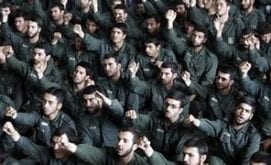iranintl – Each year as Iranian officials extoll IRGC commander Qassem Soleimani on the anniversary of his death, they inadvertently affirm the reasons behind the US decision to assassinate him.
Lawmaker Mohammad Esmail Kosari — who is a former Revolutionary Guards commander – said this week that it was Soleimani who convinced Russian President Vladimir Putin to join Iran-backed forces in Syria to support the government of Bashar al-Assad in its fight against opposition militias and Islamic State (ISIS).
“With the authority entrusted to him by the political officials of countries, Soleimani engaged in diplomatic efforts, addressing issues in the best possible way. For example, in a meeting with Putin regarding the ISIS issue, he conveyed the concerns and justified the need for Putin to intervene. Putin accepted and joined the Resistance Front,” he said, referring to Iran’s proxy militias.
Russia and Iran did indeed become ‘strategic’ allies in Syria, propping up the Assad regime in a brutal campaign that killed at least 300,000 and brought total destruction to large parts of the country.
Kosari added that Soleimani’s expertise in irregular wars was also used in Afghanistan. After Afghanistan, he focused on Lebanon, and then organized the forces in Iraq and Syria. “All of these missions were interconnected, and I must say that these missions were assigned to Soleimani by the Supreme Leader,” he added.
After the targeted Killing of Qasem Soleimani in January 2020, former US president Donald Trump described him as “the number-one terrorist anywhere in the world.” “For years, the Islamic Revolutionary Guard Corps (IRGC) and its ruthless Quds Force — under Soleimani’s leadership — has targeted, injured, and murdered hundreds of American civilians and servicemen,” he said, adding, “Soleimani has been perpetrating acts of terror to destabilize the Middle East for the last 20 years.”
In more than two decades at the head of the IRGC’s extraterritorial Quds forces, Soleimani managed to create a loose but effective coalition of forces spanning from Yemen to Lebanon, all with domestic interest but united in their enmity towards Israel and the US.
In the past few days, state-affiliated media in Iran have also published many other accounts of Soleimani’s “achievements” in the region and beyond, including a lesser-known story of his role in the Bosnian war in the early 1990s.
In an interview with the IRGC-affiliated Tasnim News, former commander of IRGC forces in Syria Mohammad Jafar Asadi described how Soleimani got involved in a European civil war almost immediately after taking charge of the Quds Force. He oversaw weapons shipped to the Balkans, where Iran was supporting Muslim Bosnians.
Soleimani’s name once more became ubiquitous in Iran’s state-affiliated media after Hamas’ rampage of Israel on October 7, with many officials hailing the attack as an ultimate fruition of his efforts, while at the same time denying any direct involvement in the planning or execution of the operation.
In a lengthy piece this week, the hardline paper Farhikhtegan said that Soleimani played a crucial role in supplying weapons to Gaza and even the West Bank — revealed by the US State Department which estimated Hamas alone being funded to the value of $100m annually with tens of millions more to other militias such as Palestinian Islamic Jihad.
Farhikhtegan revealed how Soleimani stressed the importance of domestic production of weapons in Gaza and Yemen — where Houthis have become a major concern, disrupting the flow of vessels in the Red Sea to and from the Suez Canal. However, this home-grown weaponry, in addition to that smuggled in, still comes in large part from Iranian funding and provisions in addition to training.
In 2021, Iran International published a three-hour confidential interview with Zarif meant to remain in government archives that led to a political storm in Iran. In the interview, Zarif criticized the extent of influence the Revolutionary Guards, particularly the late IRGC commander, had over Iran’s foreign policy. He also claimed that Soleimani’s visit to Moscow immediately after the 2015 nuclear deal was forged as an attempt to destroy the nuclear deal. “That trip was made upon Moscow’s initiative without the Iranian Foreign Ministry having any control on it. Its objective was to destroy the JCPOA.”
On the fourth anniversary of Soleimani’s death on Wednesday, twin bombings killed about 85 people who had gathered at his grave in Kerman, prompting Iranians to question how many more casualties the commander would cause even after his death. During Soleimani’s burial procession in 2020, about 60 people were crushed to death in a stampede.
One of the bloodiest incidents surrounding Soleimani’s death happened a few days after his assassination. Only hours after the IRGC had fired more than a dozen missiles at Iraqi bases hosting US troops in retaliation for Soleimani’s killing, the IRGC, responsible for the air defense of the capital Tehran and expecting retaliation from the US, shot down Ukraine’s flight PS752 as it took off from Tehran’s Imam Khomeini International Airport, killing 176 people onboard.
Abdollah Naseri, a former CEO of state news agency IRNA, criticized the Islamic Republic authorities for the huge propaganda campaign to portrait Soleimani as a national hero, the commander all but deified by the regime in his absence, from busts and statues in his honor to homages paid to him since his death in 2020. He claimed he has actually been a 30-year burden on the nation without offering anything.
A lot of lives would have been saved if the US had killed Soleimani long ago, Trump said after killing Soleimani, emphasizing that Soleimani had been “perpetrating acts of terror to destabilize the Middle East for the last 20 years.”
“Soleimani is not an icon because he has done nothing for the people of Iran,” Naseri said.
 Shabtabnews In this dark night, I have lost my way – Arise from a corner, oh you the star of guidance.
Shabtabnews In this dark night, I have lost my way – Arise from a corner, oh you the star of guidance.



